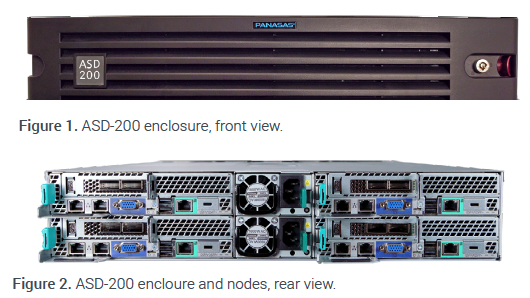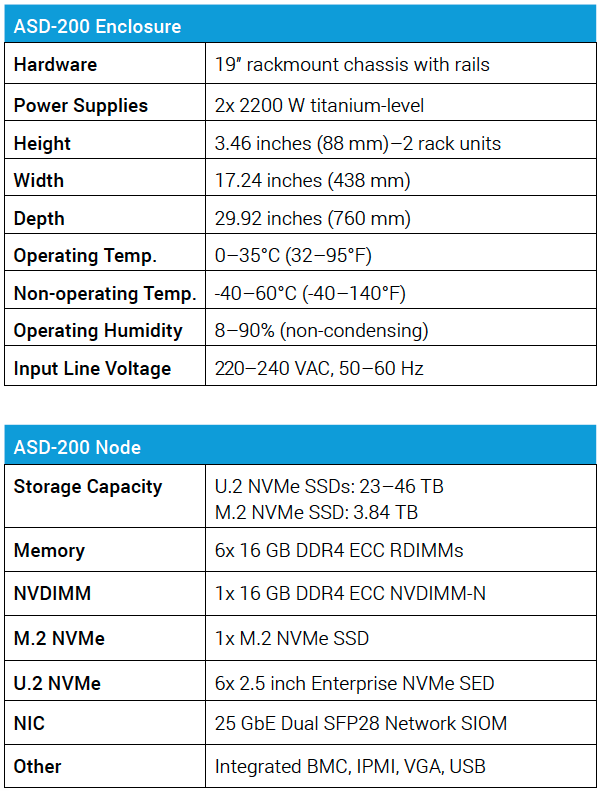This website uses cookies so that we can provide you with the best user experience possible. Cookie information is stored in your browser and performs functions such as recognising you when you return to our website and helping our team to understand which sections of the website you find most interesting and useful.
High-Performance Metadata Director Node

The ActiveStor® Director 200 (ASD-200) is Panasas’® meta-data director node and the control plane for the ActiveStor high-performance data storage solution. The ASD-200 is built on industry-standard hardware chosen for its carefully balanced hardware architecture that enables independent scaling and to meet the requirements of metadata-intensive applications in manufacturing, life sciences, energy, financial services, academia, and government.
ASD-200 director nodes are powered by PanFS®, the Panasas parallel file system, and control many aspects of the overall storage solution including file system semantics, namespace management, distribution and consistency of user data on storage nodes, system health, failure recovery, and gateway functionality. Together with ActiveStor storage nodes and the DirectFlow® driver on client systems, PanFS delivers the highest performance with unlimited scalability, enterprise reliability, and ease of management. As the system scales, reliability and availability increase while administrative overhead remains low.
ASD-200 Enclosure
The ASD-200 director enclosure is a 2U, 19” rackmount, 4-node chassis, as shown in Figure 1. Each enclosure can house up to four ASD-200 director nodes and includes redundant power supplies, as shown in Figure 2.
ASD-200 Node
The ASD-200 director node is a server node running the PanFS parallel file system. The node has been selected for its form factor and overall quality and reliability. It has been configured and tested with focus on the strength of the CPU, DRAM capacity, and networking bandwidth.
Scalable Metadata Services
ASD-200 director nodes manage system activity and provide clustered metadata services. The nodes orchestrate file system activity and speed data transfers while facilitating scalability and virtualizing data objects across all available storage nodes. This enables the system to be viewed as a single, easily-managed global namespace.
PanFS metadata services running on ASD-200 nodes implement all file system semantics and manage sharding of data across the storage nodes. They control distributed file system operations such as file-level and object-level metadata consistency, client cache coherency, recoverability from interruptions to client I/O, storage node operations, and secure multiuser access to files. Storage administrators can easily create volumes within the PanFS global namespace to manage hierarchies of directories and files that share common pools of storage capacity. Per-user capacity quotas can be defined at the volume level. Each volume has a set of management services to govern the quotas and snapshots for that volume. This type of partitioning allows for easy linear scaling of metadata performance.
Superior Manageability
A single point of management for a scale-out file system allows the storage administrator to focus on core business tasks instead of the storage system. Panasas easily addresses capacity and performance planning, mount point management, and data load balancing across multiple pools of storage. ASD-200 director nodes easily integrate into growing heterogeneous environments through the high-per-formance DirectFlow protocol support for Linux and multi-protocol support for NFS and SMB.
Gateway Services
ASD-200 directors provide scalable access for client systems via NFS or SMB protocol “gateway” services. Director nodes do this without being in the data path. Using these gateway solutions, users can easily manage files created by Windows environments. User authentication is managed via a variety of options including Active Directory and Lightweight Directory Access Protocol (LDAP).
File-level Reconstruction
Data protection in the PanFS operating environment is calculated on a per-file basis rather than per-drive or within a RAID group, as in other architectures. ASD-200 directors also provide an additional layer of data protection called Extended File System Availability (EFSA) for the namespace, directory hierarchy, and file names. In the extremely unlikely event of encountering errors that erasure coding cannot recover from, the system knows which files have been affected and fenced off and which files are known to not have been impacted.
High Availability
All metadata transactions are journaled on a backup di-rector node. All volumes remain online in case of failover, with no required system check. Network failover ensures there is no single point of failure in the system network. All director nodes share the reconstruction workload and enable load balancing during reconstruction, providing fast reconstruction within hours rather than days.
Automatic data rebuilding protects against system-wide failures. Redundant networking data paths automatically fail over. All components are hot-swapped for easy field servicing. EFSA takes advantage of erasure coding of directory data to preserve file system integrity and accessibility.
ASD-200 Specifications

Timely, High-Quality Service and Support
Unlike open-source solutions and even commercial alternatives from broad portfolio vendors, Panasas offers timely, world-class L1–L4 support.
More Information and Ordering Details
For more information and ASD-200 ordering details, contact your local Panasas representative or visit panasas.com/products/activestor-director.
-
High-Performance Metadata Director Node
High-Performance Metadata Director Node

The ActiveStor® Director 200 (ASD-200) is Panasas’® meta-data director node and the control plane for the ActiveStor high-performance data storage solution. The ASD-200 is built on industry-standard hardware chosen for its carefully balanced hardware architecture that enables independent scaling and to meet the requirements of metadata-intensive applications in manufacturing, life sciences, energy, financial services, academia, and government.
ASD-200 director nodes are powered by PanFS®, the Panasas parallel file system, and control many aspects of the overall storage solution including file system semantics, namespace management, distribution and consistency of user data on storage nodes, system health, failure recovery, and gateway functionality. Together with ActiveStor storage nodes and the DirectFlow® driver on client systems, PanFS delivers the highest performance with unlimited scalability, enterprise reliability, and ease of management. As the system scales, reliability and availability increase while administrative overhead remains low.
-
ASD-200 Enclosure
ASD-200 Enclosure
The ASD-200 director enclosure is a 2U, 19” rackmount, 4-node chassis, as shown in Figure 1. Each enclosure can house up to four ASD-200 director nodes and includes redundant power supplies, as shown in Figure 2.
-
ASD-200 Node
ASD-200 Node
The ASD-200 director node is a server node running the PanFS parallel file system. The node has been selected for its form factor and overall quality and reliability. It has been configured and tested with focus on the strength of the CPU, DRAM capacity, and networking bandwidth.
-
Scalable Metadata Services
Scalable Metadata Services
ASD-200 director nodes manage system activity and provide clustered metadata services. The nodes orchestrate file system activity and speed data transfers while facilitating scalability and virtualizing data objects across all available storage nodes. This enables the system to be viewed as a single, easily-managed global namespace.
PanFS metadata services running on ASD-200 nodes implement all file system semantics and manage sharding of data across the storage nodes. They control distributed file system operations such as file-level and object-level metadata consistency, client cache coherency, recoverability from interruptions to client I/O, storage node operations, and secure multiuser access to files. Storage administrators can easily create volumes within the PanFS global namespace to manage hierarchies of directories and files that share common pools of storage capacity. Per-user capacity quotas can be defined at the volume level. Each volume has a set of management services to govern the quotas and snapshots for that volume. This type of partitioning allows for easy linear scaling of metadata performance.
-
Superior Manageability
Superior Manageability
A single point of management for a scale-out file system allows the storage administrator to focus on core business tasks instead of the storage system. Panasas easily addresses capacity and performance planning, mount point management, and data load balancing across multiple pools of storage. ASD-200 director nodes easily integrate into growing heterogeneous environments through the high-per-formance DirectFlow protocol support for Linux and multi-protocol support for NFS and SMB.
-
Gateway Services
Gateway Services
ASD-200 directors provide scalable access for client systems via NFS or SMB protocol “gateway” services. Director nodes do this without being in the data path. Using these gateway solutions, users can easily manage files created by Windows environments. User authentication is managed via a variety of options including Active Directory and Lightweight Directory Access Protocol (LDAP).
-
File-level Reconstruction
File-level Reconstruction
Data protection in the PanFS operating environment is calculated on a per-file basis rather than per-drive or within a RAID group, as in other architectures. ASD-200 directors also provide an additional layer of data protection called Extended File System Availability (EFSA) for the namespace, directory hierarchy, and file names. In the extremely unlikely event of encountering errors that erasure coding cannot recover from, the system knows which files have been affected and fenced off and which files are known to not have been impacted.
-
High Availability
High Availability
All metadata transactions are journaled on a backup di-rector node. All volumes remain online in case of failover, with no required system check. Network failover ensures there is no single point of failure in the system network. All director nodes share the reconstruction workload and enable load balancing during reconstruction, providing fast reconstruction within hours rather than days.
Automatic data rebuilding protects against system-wide failures. Redundant networking data paths automatically fail over. All components are hot-swapped for easy field servicing. EFSA takes advantage of erasure coding of directory data to preserve file system integrity and accessibility.
-
ASD-200 Specifications
ASD-200 Specifications

-
Timely, High-Quality Service and Support
Timely, High-Quality Service and Support
Unlike open-source solutions and even commercial alternatives from broad portfolio vendors, Panasas offers timely, world-class L1–L4 support.
More Information and Ordering Details
For more information and ASD-200 ordering details, contact your local Panasas representative or visit panasas.com/products/activestor-director.
DOWNLOAD THE PDF
Thank you!
We’ve sent you full access via email. If you have any questions please contact us at clientservices@panasas.com.
